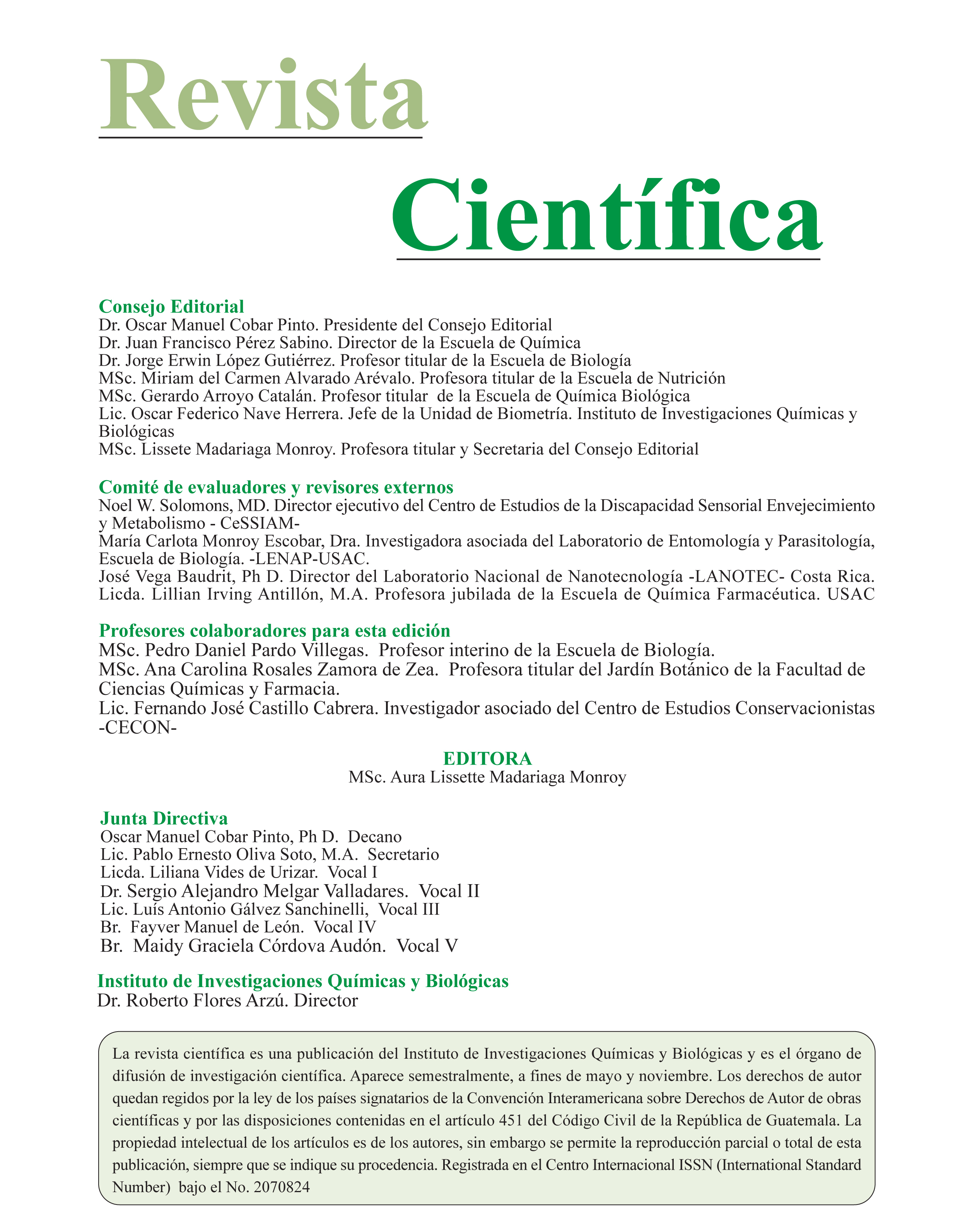Evaluation of air pollution by microscopic fungi in the Herbarium of the University of San Carlos of Guatemala, Index seminum and the macrofungi section of the Herbarium of Biology of Guatemala
DOI:
https://doi.org/10.54495/Rev.Cientifica.v23i1.109Keywords:
Air quality, microscopic fungi, biocolector, herbarium, air samplingAbstract
The indoor and outdoor quality air was determined at the University of San Carlos of Guatemala Herbarium (USCG Herbarium), the Index seminum and macrofungi section of Biology of Guatemala Herbarium (BIGU Herbarium). It was used a volumetric impactation technic through a biocolector in order to collect microscopic fungi. Sampling was carried out from October 2011 through March 2012. Further identification was performed through microscopic observation using lactophenol blue staining and also using API 20C AUX was for yeast identification. Results indicate that in USCG Herbarium environments, the highest concentration in the outdoor 3580 UFC/m3 and 300 UFC/m3 for the indoor, Index seminum 1860 UFC/m3 for the outdoor and 2300 UFC/m3 for the indoor, to microfungi section of BIGU Herbarium the highest concentration was 2790 UFC/m3 for the outdoor and 1630 UFC/m3 for the indoor. During the months in wich the sampling was carried out, it was observed that the predominant fungi in both environments and in all sampled areas were Penicillium sp, Cladosporium sp y Aspergillus sp. It was possible to isolate fungal genera of great importance for its cellulolytic and phytopathogenic action, such as Aspergillus sp., Penicillium sp., Fusarium sp. y Paecilomyces sp. The isolation of the fungal genera made it possible to create a strain library applying the mineral oil conservation technique. It was created a guide containing information about cleaning procedures according to biosafety infrastructure and raw materials for each establishment.
Downloads
References
Alright, D. (2001). Human health effects of airborne mycotoxins exposure in fungi-contaminated indoor environment. Professional Safety. Estados Unidos: Autor.
Angulo, J., Mediavilla, I., Bustos, I. & Domínguez, E. (1999). Especies fúngicas aisladas de las hojas de encina (Quercus rotundifolia) en el Parque Natural de Hornachuelos (Córdoba). XIII Simposio de Botánica Criptogámica. Madrid.
Arenas, R. (2,003).Micología Médica ilustrada. 2ed. México: McGraw Hill Interamericana.
Berlongieri, A. (1999) Differences in the amount of fungi found in the air indoors and outdoors. J. Introductory Micro- biol. 2: 9-11.
Calderón, C., Lacey, J., McCartney, A. & Rosas, I. (1997). Influence of urban climate upon distribution of airborne Deuteromycete spore concentration in México City. Biometeorol. 40(3) pp. 71 – 80. https://doi.org/10.1007/s004840050021 DOI: https://doi.org/10.1007/s004840050021
Castañeda E., Montes M. y Avelino F., (2006). Cuantificación de bioaerosoles en las áreas de proceso de una industria zapatera y su relación con la salud de los trabajadores, Enfermedades Infecciosas y Microbiología. 26:1-5.
Emberlin, J., Newman, T. & Bryant, R. (1995). The incidence of fungal spores in the ambient air and inside homes: evidence from London. Revista Aerobiologia 11 (2), 253-258. https://doi.org/10.1007/BF02447205 DOI: https://doi.org/10.1007/BF02447205
Emberlin, J., Newman, T. & Bryant, R. (1995). The incidence of fungal spores in the ambient air and inside homes: evidence from London. Revista Aerobiologia 11 (2), 253-258. https://doi.org/10.1007/BF02447205 DOI: https://doi.org/10.1007/BF02447205
Fernández, D., Valencia, R., M, Molinar., T, Vega. & Sagües, E. (1998). Daily and seasonal variations of Alternaria and Cladosporium airborne spores in León. Revista Aerobiologia. (14)2, 215-220. https://doi.org/10.1007/BF02694209 DOI: https://doi.org/10.1007/BF02694209
Gallo, F., Valenti P., Colaizzi, P., Sclocchi, M., Pasquariello, G., Scorrano, M… & Persiana A. (1996). Research on the viability of fungal spores in relation to different microclimates and materials. International Conference on Conservation and Restopration of Archive and Library Materials. Revista Erice. 12(1). 177-193.
Latge, J. (1999). Aspergillus fumigatus and aspergilosis. Revista Clinical Microbiol. 12:310-350. https://doi.org/10.1159/000060304 DOI: https://doi.org/10.1128/CMR.12.2.310
Mediavilla, A., Angulo, J., Infante, F., Comtois, P. & Domínguez, E. (1998). Prelimi- nary stadistical modeling of the presence of two conidial types of Cladosporium in the atmosphere of Córdoba. Spain . Aerobiologia 14(2,3): 229-234. https://doi.org/10.1007/BF02694211 DOI: https://doi.org/10.1007/BF02694211
Michalski, S. (2000). Guideli for Humidity and Temperature for Canadian Archives. Canadian, Ottawa: Conservation Institute.
Milagros, C. y Nieves, R. (1994). Principios básicos de la conservación documental y causas de su deterioro. Dirección General de Bellas Artes y Bienes Culturales.
Petushkova, J. & Kandyba, P. (1999). Aeromicrobiological studies in the Moscow cathedrals. Aerobiología. 15(4). 193-201. https://doi.org/10.1023/A:1007546224493 DOI: https://doi.org/10.1023/A:1007546224493
Pitt, J. (1986). A laboratory guide to common Penicillium species. Commonwealth Scientific and Industrial Research Organisation, 18 (3), 25.
Rico M. (1998). Fundamentos de Microbiología. Santa Fe de Bogotá, Colombia: Centro Editorial Javeriano., p. 27-32
Rojas, D., Ojas, J., Espinosa, G., Espinosa, A., González, C. Vidal, G., Zaragoza, P. & Aragoza. Caracterización aerobiológica de ambientes intramuro en presencia de cubiertas vegetales. Revista internacional Contam. 26 (4) 279-289.
Rosas, I., Calderón, C., Martínez, L., Ulloa, M. & Lacey, J. (1997). Indoor and outdoor airborne fungal propagule concentrations in Mexico city. Revista Aerobiología 13 (1): 23-30. https://doi.org/10.1007/BF02694787 DOI: https://doi.org/10.1007/BF02694787
Sanchez,C., y Martinez, P. (1997). Factores que favorecen el crecimiento fungico. Madrid, España: Autor.
Yang, C., y Johanning, E. (1997): Airborne fungi and mycotoxins. Manual of environmental microbiology. Estados Unidos, Washington: American Society for Microbiology.
Downloads
Published
How to Cite
Issue
Section
License
Copyright (c) 2013 K. Herrera, O. Cobar, R. Barrios, K. Pierola, W. Chamalé, C. Rosales, J. Quan, O. Fuentes, C. De León

This work is licensed under a Creative Commons Attribution 4.0 International License.
Authors who publish with this journal agree to the following terms:
- Authors retain copyright and grant the journal right of first publication with the work simultaneously licensed under a Creative Commons Attribution License 4.0 that allows others to share the work with an acknowledgement of the work's authorship and initial publication in this journal.
- Authors are able to enter into separate, additional contractual arrangements for the non-exclusive distribution of the journal's published version of the work (e.g., post it to an institutional repository or publish it in a book), with an acknowledgement of its initial publication in this journal.
- Authors are permitted and encouraged to post their work online (e.g., in institutional repositories or on their website) prior to and during the submission process, as it can lead to productive exchanges, as well as earlier and greater citation of published work.









